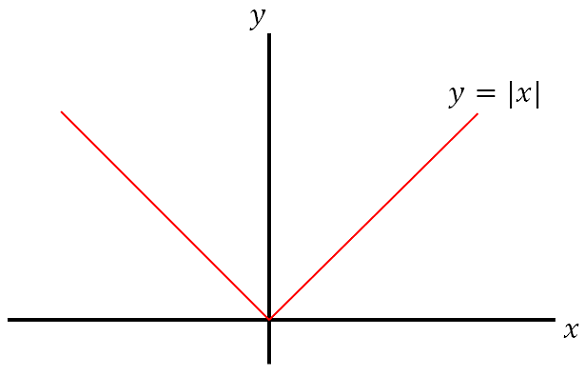Absolute Value

For a real number, the absolute value of \(x\), denoted \( \lvert x \rvert \), is defined as
Here are some properties of the absolute value:
Non-negative: for all real values.
and for all real values.
Multiplicative: .
Sub-additive: .
Symmetry: .
Distance to origin: measures the geometric distance of the real number to the origin . Since distance is always positive, the absolute value of a number is always positive. Thinking of absolute value as the distance from zero is also helpful when considering complex numbers . This distance from to the origin is given by the distance formula: In fact, this is also the definition of the absolute value for a complex number :
Worked Examples
1. Find all real values satisfying .
Solution 1: If , then we need to solve , which gives . This satisfies the original condition of , hence is a valid solution. If , then we need to solve , which gives or . This satisfies the original condition of , hence is a valid solution.
Solution 2: Using property 2, we obtain , or , which reduces to . This has solutions . We can verify that both of these are solutions.
2. How many real values satisfy ?
Solution: Let's approach this problem by considering the different regions. We have . Also, .
If then we have , or . This has roots , of which only the choice of satisfies . There is one solution in this case.
If , then we have , or . This has roots which are not real. Hence, there are no solutions in this case.
If , then we have , or . We check that the root is within this domain. Hence, there is one solution in this case.
If , then we have , or . This has no real root.
Hence, there are two real values which satisfy .
3. Prove the sub-additive property:
Solution 1: We apply the triangle inequality to the triangle with vertices , , on the real number line. Then , implying .
Solution 2:
If , then , so .
If , then , so .
If , then so . Likewise, if .
If , then , so . Likewise, if .
For more problems, see the Technique Trainer.
Easy Math Editor
This discussion board is a place to discuss our Daily Challenges and the math and science related to those challenges. Explanations are more than just a solution — they should explain the steps and thinking strategies that you used to obtain the solution. Comments should further the discussion of math and science.
When posting on Brilliant:
*italics*or_italics_**bold**or__bold__paragraph 1
paragraph 2
[example link](https://brilliant.org)> This is a quote# I indented these lines # 4 spaces, and now they show # up as a code block. print "hello world"\(...\)or\[...\]to ensure proper formatting.2 \times 32^{34}a_{i-1}\frac{2}{3}\sqrt{2}\sum_{i=1}^3\sin \theta\boxed{123}Comments
Typo in #1, Sol'n 2: (x−3)2=∣x−2∣2. I believe it should be ∣x−3∣2.
Log in to reply
Updated. Thanks!
Typo in #2: In the first line of math text of the solution, it should read x≤−1,x≥1
Log in to reply
Updated. Thanks!
Log in to reply
Welcome!
Log in to reply
You didn't even say anything,
How is the result in the fist line of Solution 2 for Example 1 made? Apologies, I'm a little confused.
Log in to reply
If you are referring to the "(x−3)2=∣x−2∣2," it is simply a typo and should read "∣x−3∣2."
Log in to reply
Yes, I was just trying to confirm that it was a typo. Thank you!
An alternative proof of the sub-additive property:
Recall that if a,b≥0, then a≤b is equivalent to a2≤b2.
Let a=∣x+y∣,b=∣x∣+∣y∣. We now need to show that a2≤b2, i.e. x2+y2+2xy≤x2+y2+2∣x∣∣y∣.This is true since xy≤∣xy∣=∣x∣∣y∣.
Nice post Master Calvin, I am waiting it ready to post in the blog.. :D
awesum post......i was really in need of clarification over this topic....thank u Calvin Sir. ....
Hi,calvin l. I read this article on high school in my country, When you learn it?
Log in to reply
I'm not certain what you mean. Absolute value is generally taught in high school.